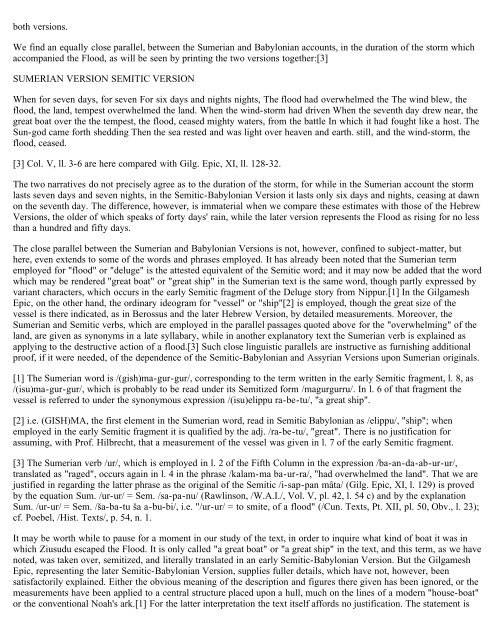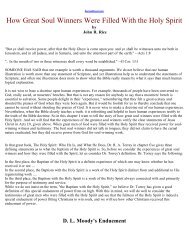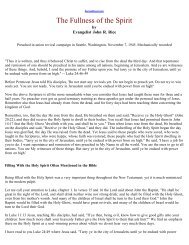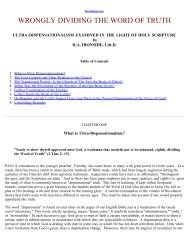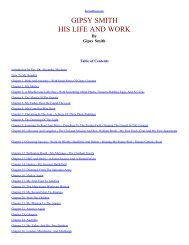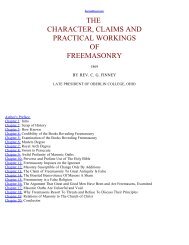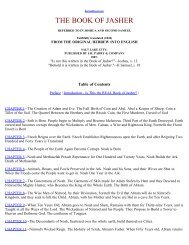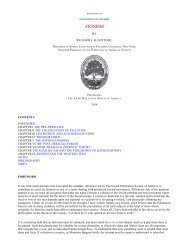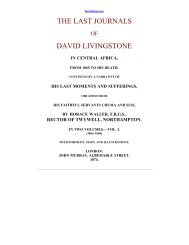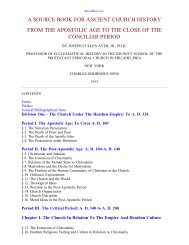Legends of Babylon and Egypt in Relation to Hebrew Tradition.pdf
Legends of Babylon and Egypt in Relation to Hebrew Tradition.pdf
Legends of Babylon and Egypt in Relation to Hebrew Tradition.pdf
You also want an ePaper? Increase the reach of your titles
YUMPU automatically turns print PDFs into web optimized ePapers that Google loves.
oth versions.<br />
We f<strong>in</strong>d an equally close parallel, between the Sumerian <strong>and</strong> <strong>Babylon</strong>ian accounts, <strong>in</strong> the duration <strong>of</strong> the s<strong>to</strong>rm which<br />
accompanied the Flood, as will be seen by pr<strong>in</strong>t<strong>in</strong>g the two versions <strong>to</strong>gether:[3]<br />
SUMERIAN VERSION SEMITIC VERSION<br />
When for seven days, for seven For six days <strong>and</strong> nights nights, The flood had overwhelmed the The w<strong>in</strong>d blew, the<br />
flood, the l<strong>and</strong>, tempest overwhelmed the l<strong>and</strong>. When the w<strong>in</strong>d-s<strong>to</strong>rm had driven When the seventh day drew near, the<br />
great boat over the the tempest, the flood, ceased mighty waters, from the battle In which it had fought like a host. The<br />
Sun-god came forth shedd<strong>in</strong>g Then the sea rested <strong>and</strong> was light over heaven <strong>and</strong> earth. still, <strong>and</strong> the w<strong>in</strong>d-s<strong>to</strong>rm, the<br />
flood, ceased.<br />
[3] Col. V, ll. 3-6 are here compared with Gilg. Epic, XI, ll. 128-32.<br />
The two narratives do not precisely agree as <strong>to</strong> the duration <strong>of</strong> the s<strong>to</strong>rm, for while <strong>in</strong> the Sumerian account the s<strong>to</strong>rm<br />
lasts seven days <strong>and</strong> seven nights, <strong>in</strong> the Semitic-<strong>Babylon</strong>ian Version it lasts only six days <strong>and</strong> nights, ceas<strong>in</strong>g at dawn<br />
on the seventh day. The difference, however, is immaterial when we compare these estimates with those <strong>of</strong> the <strong>Hebrew</strong><br />
Versions, the older <strong>of</strong> which speaks <strong>of</strong> forty days' ra<strong>in</strong>, while the later version represents the Flood as ris<strong>in</strong>g for no less<br />
than a hundred <strong>and</strong> fifty days.<br />
The close parallel between the Sumerian <strong>and</strong> <strong>Babylon</strong>ian Versions is not, however, conf<strong>in</strong>ed <strong>to</strong> subject-matter, but<br />
here, even extends <strong>to</strong> some <strong>of</strong> the words <strong>and</strong> phrases employed. It has already been noted that the Sumerian term<br />
employed for "flood" or "deluge" is the attested equivalent <strong>of</strong> the Semitic word; <strong>and</strong> it may now be added that the word<br />
which may be rendered "great boat" or "great ship" <strong>in</strong> the Sumerian text is the same word, though partly expressed by<br />
variant characters, which occurs <strong>in</strong> the early Semitic fragment <strong>of</strong> the Deluge s<strong>to</strong>ry from Nippur.[1] In the Gilgamesh<br />
Epic, on the other h<strong>and</strong>, the ord<strong>in</strong>ary ideogram for "vessel" or "ship"[2] is employed, though the great size <strong>of</strong> the<br />
vessel is there <strong>in</strong>dicated, as <strong>in</strong> Berossus <strong>and</strong> the later <strong>Hebrew</strong> Version, by detailed measurements. Moreover, the<br />
Sumerian <strong>and</strong> Semitic verbs, which are employed <strong>in</strong> the parallel passages quoted above for the "overwhelm<strong>in</strong>g" <strong>of</strong> the<br />
l<strong>and</strong>, are given as synonyms <strong>in</strong> a late syllabary, while <strong>in</strong> another explana<strong>to</strong>ry text the Sumerian verb is expla<strong>in</strong>ed as<br />
apply<strong>in</strong>g <strong>to</strong> the destructive action <strong>of</strong> a flood.[3] Such close l<strong>in</strong>guistic parallels are <strong>in</strong>structive as furnish<strong>in</strong>g additional<br />
pro<strong>of</strong>, if it were needed, <strong>of</strong> the dependence <strong>of</strong> the Semitic-<strong>Babylon</strong>ian <strong>and</strong> Assyrian Versions upon Sumerian orig<strong>in</strong>als.<br />
[1] The Sumerian word is /(gish)ma-gur-gur/, correspond<strong>in</strong>g <strong>to</strong> the term written <strong>in</strong> the early Semitic fragment, l. 8, as<br />
/(isu)ma-gur-gur/, which is probably <strong>to</strong> be read under its Semitized form /magurgurru/. In l. 6 <strong>of</strong> that fragment the<br />
vessel is referred <strong>to</strong> under the synonymous expression /(isu)elippu ra-be-tu/, "a great ship".<br />
[2] i.e. (GISH)MA, the first element <strong>in</strong> the Sumerian word, read <strong>in</strong> Semitic <strong>Babylon</strong>ian as /elippu/, "ship"; when<br />
employed <strong>in</strong> the early Semitic fragment it is qualified by the adj. /ra-be-tu/, "great". There is no justification for<br />
assum<strong>in</strong>g, with Pr<strong>of</strong>. Hilbrecht, that a measurement <strong>of</strong> the vessel was given <strong>in</strong> l. 7 <strong>of</strong> the early Semitic fragment.<br />
[3] The Sumerian verb /ur/, which is employed <strong>in</strong> l. 2 <strong>of</strong> the Fifth Column <strong>in</strong> the expression /ba-an-da-ab-ur-ur/,<br />
translated as "raged", occurs aga<strong>in</strong> <strong>in</strong> l. 4 <strong>in</strong> the phrase /kalam-ma ba-ur-ra/, "had overwhelmed the l<strong>and</strong>". That we are<br />
justified <strong>in</strong> regard<strong>in</strong>g the latter phrase as the orig<strong>in</strong>al <strong>of</strong> the Semitic /i-sap-pan mâta/ (Gilg. Epic, XI, l. 129) is proved<br />
by the equation Sum. /ur-ur/ = Sem. /sa-pa-nu/ (Rawl<strong>in</strong>son, /W.A.I./, Vol. V, pl. 42, l. 54 c) <strong>and</strong> by the explanation<br />
Sum. /ur-ur/ = Sem. /ša-ba-tu ša a-bu-bi/, i.e. "/ur-ur/ = <strong>to</strong> smite, <strong>of</strong> a flood" (/Cun. Texts, Pt. XII, pl. 50, Obv., l. 23);<br />
cf. Poebel, /Hist. Texts/, p. 54, n. 1.<br />
It may be worth while <strong>to</strong> pause for a moment <strong>in</strong> our study <strong>of</strong> the text, <strong>in</strong> order <strong>to</strong> <strong>in</strong>quire what k<strong>in</strong>d <strong>of</strong> boat it was <strong>in</strong><br />
which Ziusudu escaped the Flood. It is only called "a great boat" or "a great ship" <strong>in</strong> the text, <strong>and</strong> this term, as we have<br />
noted, was taken over, semitized, <strong>and</strong> literally translated <strong>in</strong> an early Semitic-<strong>Babylon</strong>ian Version. But the Gilgamesh<br />
Epic, represent<strong>in</strong>g the later Semitic-<strong>Babylon</strong>ian Version, supplies fuller details, which have not, however, been<br />
satisfac<strong>to</strong>rily expla<strong>in</strong>ed. Either the obvious mean<strong>in</strong>g <strong>of</strong> the description <strong>and</strong> figures there given has been ignored, or the<br />
measurements have been applied <strong>to</strong> a central structure placed upon a hull, much on the l<strong>in</strong>es <strong>of</strong> a modern "house-boat"<br />
or the conventional Noah's ark.[1] For the latter <strong>in</strong>terpretation the text itself affords no justification. The statement is


